 | E-mail to Birds Korea |
 | KWBS |
in the Region
 | The Oriental Bird Club |
 | BirdLife International (Asia) |
May
Like April, a great birding month. Temperatures begin to climb with day maxima often reaching 25°C by the end of the month, though feeling cooler on offshore islands due to low sea temperatures and wind. Fog can temporarily limit birding, while also causing spectacular falls of migrants.
Migration continues, and guided tours to estuaries or offshore islands can expect many spectacular days. Especially in the first week, diversity can be exceptional. Lesser Sandplovers, Red-necked Stints, Broad-billed and Spoon-billed Sandpipers peak at Saemangeum and other key areas, while Chestnut and Little Buntings begin to outnumber Yellow-throated and the very common Black-faced Bunting. Mugimakis, Dark-sided and Grey-streaked Flycatchers also start to arrive, peaking in the second and third weeks of the month. Brown and Tiger Shrikes, Siberian Rubythroats and Broad-billed Rollers add colour and quality to the birding mix. By late May locustella warblers (Gray's, Pallas's, Middendorf's, Styann's Grasshopper and Lanceolated) arrive on western islands. In forests Ruddy Kingfisher and Fairy Pitta are in territory and vocal, though still elusive and easily disturbed. Korean breeding Chinese Egrets and Black-faced Spoonbills remain widespread at the best sites, and Saunders's Gull also sometimes nest.
May is a prime month for finding national rarities. Korean firsts in May have included: in 2000, Ortolan Bunting and Northern Wheatear; in 2001, Himalayan Swiftlet and Asian Koel on Gageo Island, and Black Tern at Seosan; in 2002, Long-tailed Skua; in 2003, Isabelline Wheatear and Chinese Song Thrush; in 2004, an Orange-headed Thrush on Hong Island; and in 2005 three Tickell's Leaf Warblers on Socheong.
(The following records are a compilation of our own sightings and records sent in by other observers. As well as being posted on the Birds Korea website(s), selected records are also forwarded to other Korean-language birding websites; records of threatened species are arranged and forwarded to Birdlife International and national authorities when appropriate; flag images and records are passed to bodies responsible for their coordination throughout the flyway; and all records sent to us are used to compile annual reports and to support the evolving understanding of the status of many of Korea’s birds.)
Gunsan, May 24, "Owling" under a bright moon
On our observation the Oriental Scops Owl seems to be the most abundant, but Brown Hawk Owls were heard in several locations outside the south side of the city and around Eunpa Park.
Socheong Island, May 23 am
With clear skies and a brisk northerly wind, many migrants had moved on, and in the 6 hours in the field before the ferry, best included the Grey Bushchat still, a presumed new Light-vented Bulbul at the lighthouse (seen dropping in from the sea), at least 5 Daurian Starling still, and the Red Turtle Dove.
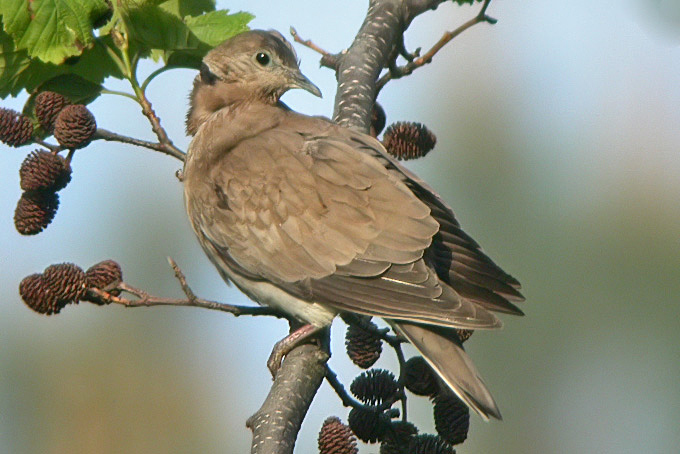
Other migrants of note included a single Amur Falcon, 2 male White-throated Rockthrush, single Blyth's Pipit, ca 7 Black Drongo, 3+ Japanese Grosbeak and a very late Brambling.
With intense haze and sea mist, the ferry journey was extremely poor, with only one loon (an apparently breeding-plumaged Pacific), several accipiters, a Brown Flycatcher and a cuckoo sp, all heading north.
Eo-cheong Mt., Geum Tidal Flats, vicintity of the airport, and Okku, May 22
After hearing them many times we finallly got a look at a calling Indian Cuckoo through the scope. A Striated Heron flew over a canal near the Keum. On the tidal flats and over the river a variety of Terns were seen: Little Terns were common, with at least oneWhite-winged Black Tern and five Whiskered Terns. A single Pochard was seen in the river after several weeks of that species being absent from our Sunday daylist. There were still a variety of shorebirds at the Mangyeung river. Common Redshanks, Grey Tattlers, groups of a dozen or two Greenshanks, a scattering of Ruddy Turnstones and dozens of Red-necked Stints were among the reduced but still sizeable assembly at Okku.
Near the airport a Black-capped Kingfisher was heard, then seen flying over the tree tops. Also of note five Eurasian Hobbies were seen in three locations.
Song Do, May 22
The first Eurasian Cuckoo this year sounded from the trees. Oriental Reed Warblers have taken up residence on the lagoon, where 4 Pochard and 9 Common Greenshank linger on. 2 Black-crowned Night herons are a new sight.
On the mudflat, the main large flocks of Dunlin, Grey Plover and Whimbrel are still present, as well as perhaps 60 busily foraging Saunders's Gulls.
Socheong Island, May 22
Following some very light overnight showers, the day remained largely cloudy, with the light wind shifting from SW to NW. Yet another surprising day, with 101 species logged: an extremely high species count for so late in the spring migration period.
The day was again one for warblers, with 17 species found, and to a lesser extent flycatchers, with seven, and cuckoos with four (2 Commons, and single Little, Indian, and Hodgson's/Northern Hawk-cuckoos). Most numerous migrants included Asian Brown (35) and Yellow-rumped Flycatchers (25) (though 7 Dark-sided was the highest count so far of this very late migrating species), Dusky (30), Radde's (35), Arctic (80), Two-barred Greenish (25: a new national high count), Yellow-browed (30), Black-browed Reed (50), Lanceolated (25), and Pallas's Grasshopper/Rusty-rumped (30) Warblers.

At least 25 Brown Shrike were also present, of which three showed a very small but clear white patch at the base of the primaries (the first time this year to note such individuals). Two were sandy-backed, and one rather browner, and although one pale individual might possibly have been an Isabelline Shrike (a species as yet unrecorded in Korea), it seems more likely that all were either "extreme" Browns or even possibly Brown-Isabelline intergrades(?).

In addition, 15 Thick-billed Warbler was a new national high count, while Gray's Grasshopper (4) was also the highest count so far this year of this very late-migrating locustella. Other species of note included yet another White-breasted Waterhen (probably about the 4th or 5th individual in the past week), 15 Thick-billed Shrike, 7 Daurian Starling, 3+ Japanese Grosbeak, 4 Common Rosefinch, 2 White-throated Rockthrush, 4 Forest Wagtail, and 1 Hume's Leaf Warbler. A probable Spotted Bush Warbler was heard singing briefly at the lighthouse.
In addition to all of the above, outstanding highlights came in the form of a female Rufous-bellied Woodpecker, the same or more likely another Red Turtle Dove found in another part of the island, the same or another White-bellied Green Pigeon first heard by KM and later seen very briefly in flight by NM, 11 Black Drongo, and incredibly, yet another Tickell's Leaf Warbler: this one showing a rather broad eye-stripe in front of the eye, a narrower area of yellow on the supralorals, and rather worn-looking remiges: the third record of this species in less than a week!
Socheong Island, May 21
A largely thinly overcast day, with continuing light (Beaufort force 2-3) southwesterlies, and 93 species logged by NM.
Numbers of migrants were well down from the 20th, but again many species of note were logged, including several more outstanding national rarities. Most numerous migrants were Brown Shrike (20), Eye-browed Thrush (20), Siberian Blue Robin (30), Asian Brown (30) and Yellow-rumped Flycatchers (30), Yellow-browed (50), Arctic (30) and Pale-legged Leaf Warblers (30), while scarce migrants included single White-breasted Waterhen, Chinese Pond Heron (10), Black Drongo (now 9), White-throated Rockthrush (2), Two-barred Greenish (15) and Thick-billed (6) Warblers and a single Blyth's Pipit.
First major rarity of the day was found by KM, who found a cuckooshrike, presumably (on range) a Black-winged Cuckooshrike (only one previous national record). Searching for this in the second village, NM then found a second Tickell's Leaf Warbler (much brighter than the bird of the 19th, with a narrower supraloral, and a clear blaze on the remiges), and also a Spangled Drongo (ca 5th national record), along with 3 Chinese Blackbird. In addition, the Grey Bushchat was still present, in the same area as a long-staying Chinese Blackbird.

Socheong Island, May 20
With skies remaining clear and winds light (and from the southwest), a mass departure of migrants was only to be expected. However, numbers of many species remained high, some increased, and two further national rarities were found - this time a female Red Turtle Dove (about 5th or 6th national record?) and a male Grey Bushchat (believed only 4th national record).
Most numerous species included Siberian Blue Robin (the 115 seen or heard in the small part of the island checked most likely representing a new national high day count) and Yellow-browed Warbler (75), while Two-barred Greenish Warbler increased to 15+ (likely also a new national high count), Thick-billed Warbler to 8, and Red-throated Flycatcher to 12.
Other species of note included ca 8 Chinese Pond Heron, 2 Shrenk's Bittern and a single Yellow Bittern (both personal firsts for the spring), 12+ Thick-billed Shrike, Black Drongo (4: NM, with 5 seen by Kenji Mochizuki), 6+ Light-vented Bulbul, 4 White-throated Rock Thrush, single Blyth's Pipit and Greater Short-toed Lark and the personal first Gray's Grasshopper Warbler of the spring.
Hong Island, May 20
Highlights included Chinese Sparrow Hawk (128), Light-vented/Chinese Bulbul (1), Brown Shrike (2), Thick-billed Warbler (2), Black Drongo (14). Total of 47 Species logged during the day.
Heuksan, May 19
Sunny and clear conditions.
Highlights included: Chinese Pond Heron (10), Schrenk's Bittern (1), Little Stint (1), Richard's Pipit (12), Yellow Wagtail (65. mostly M. f. simillima), Brown Shrike (3), Yellow-breasted Bunting (55), Japanese Grosbeak (13), Grey-backed Starling (1), Red-billed Starling (1), Black Drongo (10). Total of 60 Species logged during the day.


Few warblers recorded: only 3 Arctic Warbler, 1 Eastern Crowned Willow Warbler, and 1 Yellow-browed Warbler - this is in contrast with the large numbers of warblers on Socheong, and points strongly to the use of different migration routes by birds breeding in eg Siberia and those breeding in Korea and Japan.
Socheong Island, May 19
An excellent day! With light westerly winds and clear skies, and many fewer raptors, 94 species were logged, with much higher numbers of many species.
First species for the day was Little Whimbrel, with a flock heard calling overhead at 0400 AM, while most numerous included Asian Brown (40) and Yellow-rumped (35) Flycatchers, Siberian Blue Robin (60++, with many First summer males in song), Chestnut-flanked White-eye (100), Pale-legged (50) and Yellow-browed (100) Warblers, and Yellow-breasted Bunting (ca 20). A long list of nationally scarce migrants included Amur Falcon (4, but including a full adult male this time), White-throated Rockthrush (5), Daurian Starling (1), Thick-billed (6), and Two-barred Greenish (2) Warblers, Greater Short-toed Lark (1), Chinese Blackbird (1) and Black Drongo (2-3).
Further exceptional highlights came in the form of the Rufous-bellied Woodpecker still, a male Black Bittern watched coming in over the sea (fewer than 10 national records), 2 Hume's Leaf Warblers, and in the early afternoon at the lighthouse, in amongst a wave of warblers, Korea's first Tickell's Leaf Warbler Phylloscopus affinis: extremely mobile, and very difficult to digiscope!

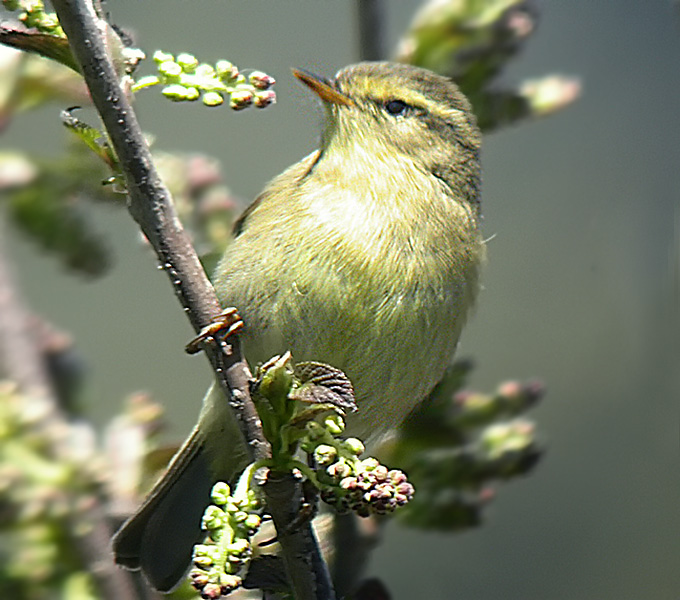
Socheong Island, May 18
Rain fell on and off through the night followed by heavy drizzle until 9 am, when for a few hours very strong northwesterly winds (gusting to gale force Beaufort 8 or 9) led to clearing skies, easing to"only" force 5 or 6 by evening.
Although birding conditions were rather difficult for much of the day, no less than 93 species were logged, with a number of noteworthy species. Remarkably few species were either present or showing in anything but very small numbers, with the only exceptions being Chinese Sparrowhawk (with a single kettle of 120 in the morning, and at least 200 present during the day), Sand Martin (40) and Yellow Wagtail (30).
However, highlights included the Rufous-bellied Woodpecker still, a male White-bellied Green Pigeon (the third record in South Korea in 2005 known to Birds Korea - but only around the 9th in total), 4 Amur Falcon showing excellently, a single Oriental Pratincole, a Chinese Grey Shrike (exceptional date for a migrant), 5+ Light-vented Bulbul, an Ochre-rumped Bunting and best of all, a Chinese Thrush (the second record for Socheong and for Korea) flushed almost underfoot as it tried to shelter on a cliff footpath.

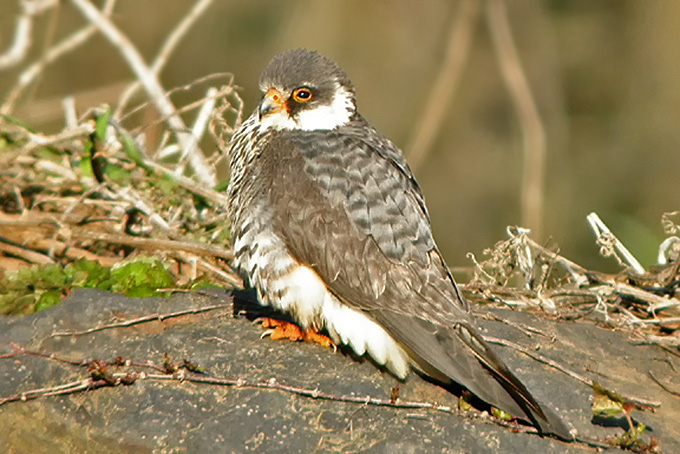
Socheong Island, May 17, (early afternoon update)
With heavy rain from 8 AM and strengthening winds, limited time spent in the field.
An early morning trip to the lighthouse and back produced a total of at least 20 Pechora Pipit moving east (along with 4 Richard's Pipit, 40 Chestnut and 5 Yellow-breasted Buntings, ca 10 Yellow and one Forest Wagtail), while a small group of Pacific Swift watched over the main village at midday in heavy rain contained one bird which appeared to have uniform dark upperparts. There are still apparently no confirmed records of Common Swift in South Korea, although "possibles" are seen (almost) annually.
Also of note was another Light-vented Bulbul, this one calling near the main village.
Incheon-Socheong Island, May 16
A slightly disappointing (and delayed) ferry journey, with for example no terns logged at all, and Black-tailed Gull (ca 300) the only gull species logged. Other species recorded from the ferry included 16 Pacific, 4 Arctic and 8 unidentified Loons (most apparently in breeding plumage), 22 Ancient Murrelet, 74 Streaked Shearwater (with a further 400 off the island in the evening), 3 Striated Heron, 7 Black-crowned Night Heron, 2 Great and one Intermediate Egret, and remarkably, considering last year's records, a single Grey Nightjar and 3 Brown Hawk Owl/Northern Boobook...
On the island itself, in only two hours, rather few migrants in the very limited area covered. However, at least 6 Radde's, 15 Yellow-browed, 5 Pale-legged, 2 Dusky, single Eastern Crowned and Pallas's Leaf along with 2 or more presumed Hume's Leaf Warblers; and 4 species of flycatcher.
Species of most note included 2 Asian House Martin, a Light-vented Bulbul heard in "fish-farm valley" (3 were recorded by Mark Brazil and 'team' on Socheong at the beginning of the month ) and best of all a male Rufous-bellied Woodpecker, highly vocal and seen briefly just behind the main village. This is the third record for Socheong (with the two previous records both in May 2004), and only the eighth record for South Korea known to Birds Korea (cf our 2004 Year Review).
Gunsan and vicinity, May 15
Over the Keum tidal mud PN noted a single White-winged Black Tern. Several Bull-headed Shrikes interacted near Oh-seong Mt., perhaps in the mate selection process. Indian Cuckoos were heard for the first time this year. On a hill near the airport both an Asian Brown (PN) and Grey-streaked Flycatchers were seen. Also in a flooded rice field nearby seven Wood Sandpipers were foraging. On the way back to Gunsan proper a Eurasian Hobby was seen perched on a power line.
Taejeongdae, Busan, May 15
I went to Taejeongdae on Buddha's birthday to see what birds I could find. Notable species included 5 Oriental Honey Buzzardsand a Eurasian Hobby. My attention was drawn to them by what I think was a wagtail flying above the forest giving an alarm call.
In the forest I heard and/or saw Japanese White-eyes, Pale Thrushes, Great Tits, Coal Tits, Long-tailed Tits, Japanese Pygmy Woodpeckers, Brown-eared Bulbuls, Ring-necked Pheasants, Jungle Crows, Black-billed Magpies and Vinous-throated Parrotbills.
From near the lighthouse I saw Black-tailed Gulls and Black Kites.
Taejondae Park, May 14
A slight breeze was experienced off and on throughout the morning making excellent birding weather.
Highlights:
Eurasian Hobby - 1 perched and vocalizing near the lower temple, Pallas Warbler - 1 mixed with the usual tits, Oriental Honey Buzzards - at least 5 noticed flying low, Black-naped Oriole - 4 seen and heard throughout the morning, Eye-browed Thrush - 2, Broad-billed Roller -1 perched at the lower temple
Namhae-do, May 15
Though I was not 'officially' birding at the time, I noticed a Black-capped Kingfisher at a local beach lookout near Namhae. What a beautiful bird! My co-workers never saw me so excited.
Nakdong Estuary, May 14 pm
Going by boat, only a small part of the inner and outer estuary was covered but several species of note were observed.
Most numerous was longipennis Common Tern, with ca 3 200 counted, and probably significantly more present (one scan produced 1240 next to the barrage, with a further single flock of 2000 found roosting ca 2 km "downstream").
This is easily the highest known day count of the species known to Birds Korea, and over three times higher than the maximum count recorded in Park Jin Young's 2002 thesis on the status of birds in Korea. Within this very large roosting flock, at least 20 Common Tern had red legs (and black bills) and apparently three different individuals were both red-legged and largely red-billed, i.e. of the subspecies 'minussensis'. Park Jin Young lists just two previous records of 'minussensis' involving three individuals: two at the Nakdong estuary in September 1990, and one in Gangneung, in October 2001.
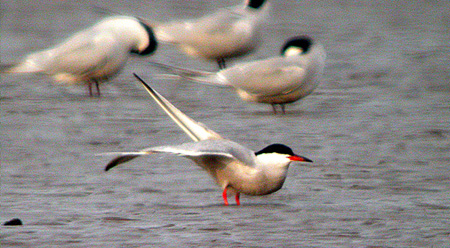
In addition to the Common Tern, at least 5 Whiskered and 2 breeding-plumaged White-winged Black Terns were also logged, while shorebirds included ca 15 Sanderling, ca 200 Red-necked Stint, a single Curlew Sandpiper, and best of all single breeding-plumaged Spoon-billed Sandpiper and Little Stint. Further birds of note included over 300 Black-headed Gull still, and single Osprey and Black Kite.
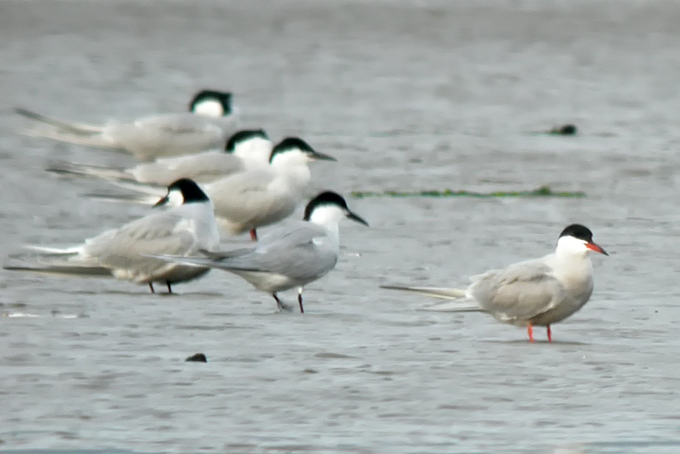

Hong Island and Heuksan Island, May 11 and 12

Large numbers of birds in inclement weather. Highlights:
White-breasted Rockthrush 1 (1st summer male), Thick-billed Warbler 2, Black Drongo 2, Chinese Blackbird 1(male), Amur Falcon 1, Rosy Pipit 1, Blyth's Pipit 1
Highlights on Heuksan Island (May 12):
Black Drongo 7, Richard's Pipit 8, Silky Starling 1, Amur Falcon 1, Black winged Stilt 1
This is about the 6th record of Rosy Pipit in South Korea, with two historic records in autumn listed by Park Jin-Young's doctoral thesis:
One on November 4th, 1889 in Gyeonggi Province;
One on October 28th 1930 in Jeollanam Province;
Followed by at least three more recent spring records (also listed by Park Jin-Young):
One breeding-plumaged, May 12th, 2000, Gageo Island (Nial Moores);
One or more likely two, photographed, April 13th-15th, 2001, Gageo Island (Nial Moores and Kim Su-Kyung).
One, April 18th 2001, Heuksan Island (Choi You-Seong).
Eocheong Island, May 9
With clear skies overnight, many of yesterday's arrivals appeared to have moved on, with only Yellow-browed Warbler (100+) more numerous.
In the morning before the boat back to the mainland, species of note included at least 3 Richard's and a single Blyth's Pipit, ca 4 Red-throated Flycatcher, 2 Forest Wagtail, a single Chinese Blackbird and 4 Black Drongo still, with outstanding highlight being a tristis Chiffchaff found (and very poorly digiscoped!) in the village. This is the second record in South Korea, following the first in April 2004. The species has also been recorded in DPRK and in Hebei, China, as well as in Japan.
From the ferry only 14 Streaked Shearwater, but ca 40 taimyrensis gulls still, as well as a single Common Tern and a Parasitic Jaeger, as well as a single Black Drongo on Yeon Do...



Hong Island, May 9
1 Black Drongo
Weiyeon Island (ca 15 km northeast of Eocheong Island), May 7 pm - May 8
Highlights:
White-breasted Waterhen 3, Watercock 1, Citrine Wagtail 2, Brown Shrike 7+, Tiger Shrike 2, White-throated Rock Thrush 2, Eye-browed Thrush 110+, Chestnut-cheeked Starling 5, White-shouldered Starling 2, Black Drongo 7


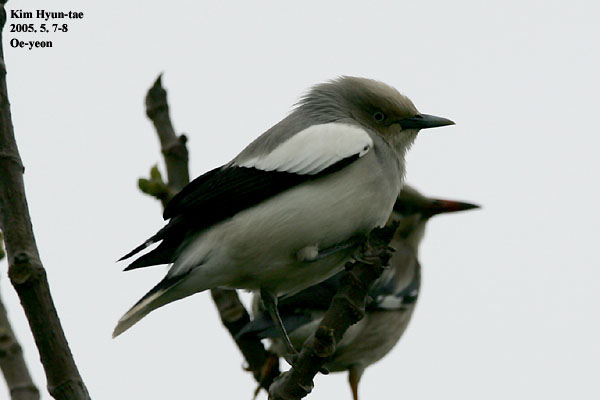

Song Do, May 8

The year's first Black-naped Oriole announced itself from trees surrounding the lagoon, while on the freshwater 6 Spotted Redshank now present themselves, as well as a sudden influx of Common Sandpipers. Notably, 2 eclipse Tufted Duck are still present.
High tide on the mudflat - and a similar dynamic of shorebirds as 3 days back, but with noticeably fewer Red-necked Stints: up to 10 Red Knot in sumptuous summer red are new arrivals.
Star visitors of the day, however, were a group of 7 gorgeous Black-faced Spoonbills - two dressed in the regal splendour of breeding crests and breastbands. They skimmed the shallows gracefully - to the backdrop of 2 jutting sea walls that will soon destroy Song Do.
Eocheong Island, May 8
With cloud and mist moving in overnight, the first bird of the day (out of an excellent 104 species logged), was a calling Grey-headed Lapwing at 5 AM. Despite searching it could not be found later, although the beach held several shorebirds including breeding-plumaged Pacific Golden (1) and Mongolian Plovers (2), a Red-necked Stint and a Sharp-tailed Sandpiper.

The early morning continued wonderfully with a single kettle of 165 Chinese Sparrowhawk (out of a day estimate of 220), flushing flocks of orioles, Broad-billed Rollers and thrushes. Although difficult to estimate numbers, a single flock (made up almost entirely of Eye-browed Thrush) contained 550 individuals, and probably at the very least 700 Eye-broweds were present during the day (the highest national count of the species known to Birds Korea).
Although the rest of the morning fell quiet, a second bank of cloud and fog rolled in at 2 PM, and a large arrival took place. Most numerous species included Asian Brown (40) and Yellow-rumped Flycatchers (50), Dusky (70), Raddes' (35), Eastern Crowned (120), Pale-legged Leaf (ca 100) and Yellow-browed Warblers (ca 50), Olive-backed Pipit (ca 80), Black-faced (30), Chestnut (50) and Little Buntings (ca 75).
Other species of note included 10 Black-capped Kingfisher and 18 Brown Shrike (both high counts for Eocheong), the personal first Common Cuckoo of the spring, one Chinese Blackbird still, 4 Red-billed Starling (both very late records), a House Swift, 5 Black Drongo, a Hume's Leaf and at least two Two-barred Greenish Warblers.
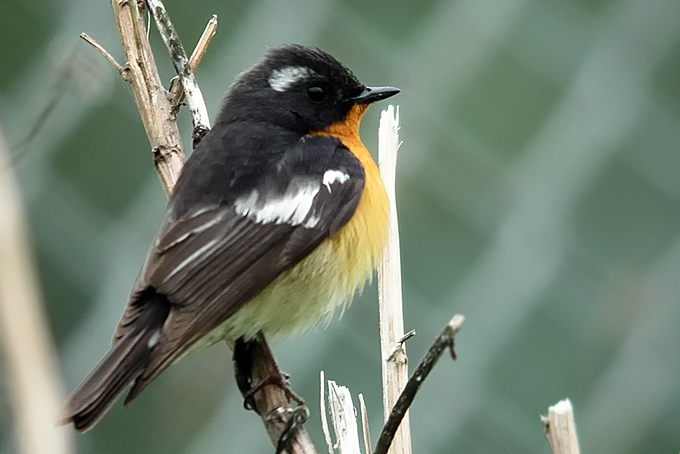
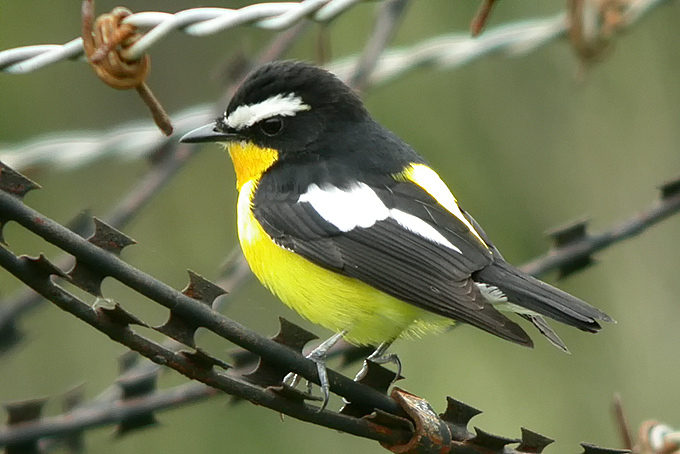
Gunsan Industrial Zone and Mangyeong Estuary at Okku, May 7
Okku was very active with shorebirds. Thousands of Great Knots interspersed with Red Knots, large groups of Dunlins, Mongolian Plovers and Terek Sandpipers seemed to be the bulk of the shorebird population. A single Black-faced Spoonbill was seen at a distance. There as well, groups of Red-necked Stints within which RN spotted a Spoon-billed Sandpiper briefly.
Also, in the estuary a couple of late Pintails were observed. During high tide, a search of the ponds revealed a group of a dozen Common Redshanks and perhaps a couple of dozen Grey-tailed Tattlers. A Curlew Sandpiper was there as well. While PN and I continued to search the ponds for our own Spoon-billed Sandpiper, RN got a Nordmann's Greenshank among Common Greenshanks on the flats.
Oh-seong Mountain, Keum Tidal Flats and the Man-gyeong Estuary at Okku, May 8
In a flowering tree near the Geum Tidal Flats a Chinese Grosbeak male continued to sing as we watched. On Oh-seong Mt. the first of three groups of Azure-winged Magpies were heard. Broad-billed Rollers were seen on the mountains west slope and another personal first of the year Black-napped Oriole. A group of six Ashy Minivets perched in the open on the south side. Also there, RN identified an Asian Brown Flycatcher. At the top of the mountain a Eurasian Hobby was watched giving serious chase to a Scaly Thrush, which doubled back around some brush and stayed low to evade the falcon's fierce run. In reeds near the Geum some Chinese Penduline Tits appeared briefly from cover.
At Okku for a second visit, a Black-capped Kingfisher crossed the road as we entered. Twenty or more Ruddy Turnstones were roosting with other shorebirds in one empty shrimp pond. Many of the same bird types were present, but new this visit were at least one Broad-billed Sandpiper, a male Ruff with plumose white breeding feathers (JM). And finally, all observed at close range a breeding plumage Spoon-billed Sandpiper.
Eocheong Island, May 7
Despite largely sunny and clear conditions (with visibility increasing to ca 100 km in the late afternoon), 96 species were logged during the day, with a decent arrival taking place during the afternoon made up largely of warblers (with ca 150 logged) and flycatchers - comprising Blue-and-White (1), Grey-streaked (5), Mugimaki (10), Asian Brown (30), Red-throated (8) and Yellow-rumped (35).
Other arrivals included 6 Brown Shrike, and an extremely late Northern Goshawk, while personal firsts for the spring included Hodgson's Hawk Cuckoo (2), Forest Wagtail (1) and Black-browed Reed Warbler (3+). Other species of note included the two Black-headed Bunting still, 2 Black Drongo, 2 House Swift, one Chinese Blackbird, 2 Red-billed and 3 Daurian Starling (CSH).
Eocheong Island, May 6
After heavy overnight rain, the day remained foggy and overcast with periods of drizzle, before cold northwesterly winds swept away the fog in the evening.
Although several high-quality species were logged, remarkably small numbers of birds were present overall, with most numerous being Red-rumped/Lesser Striated Swallow (ca 100), Barn Swallow (ca 75), Eastern Crowned Warbler (60), Pale-legged Leaf Warbler (40) and Brown Flycatcher (30).
Species of note included the personal first Arctic Warbler (1) and Sand Martin (7) of the spring, Long-toed Stint (1), Swinhoe's Snipe (1), Mongolian Plover (2), a Red-billed Starling, a male Daurian Starling still, at least 2 Japanese (and 30 Chinese) Grosbeaks, 9 species of thrush (5 Brown-headed, one Chinese Blackbird, 5 Dusky, ca 10 Eye-browed, 1 Grey, 5 Grey-backed, 20 Pale, 1 Siberian and ca 5 White's Thrushes), and 4 Brown Shrike (3 lucionensis-types and one cristatus-type).

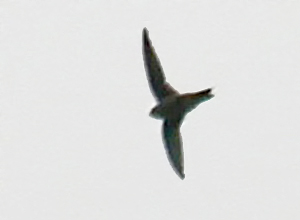
Rarest for the day were 2 Black Drongo and in the late evening a Himalayan Swiftlet (probably ca the 9th national record, after the first on May 3rd, 2001 on Gageo Island), while there were two (more?) Black-headed Buntings: a species recorded only twice in Korea prior to 2005. One was a male (with a bald patch on one side of its head, and apparently rather duller than the male of the week before?), and the other, less than 100 m distant, a "first year" female-type (Although considered as Red-headed in the field, the images reveal obvious rufous tones to the scapulars, and streaking carrying onto the forehead, both apparently strongly pro-Black-headed features). This individual apparently lacked the yellow tone to the rump on a female seen briefly in flight on the 5th, and might or might not be the same individual as that seen on April 28th (NM) and/or on May 2nd and 3rd when photographed by the team of Japanese birders (see below).
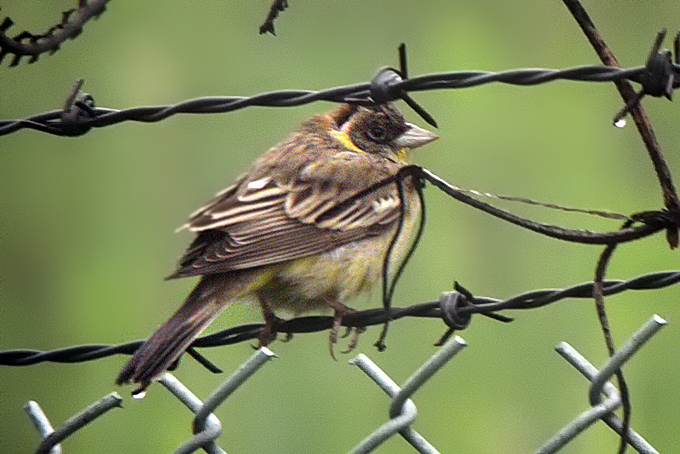

Heuksan Island, May 5 - 7
1 Tree Pipit - this follows one found here by Park Jong Gil on April 24th.
Socheong Island, May 5
On Socheong, an Isabelline Wheater - the 3rd record for Korea - observed by Mark Brazil, Mayumi Kanamura, and Kenji Mochizuki.
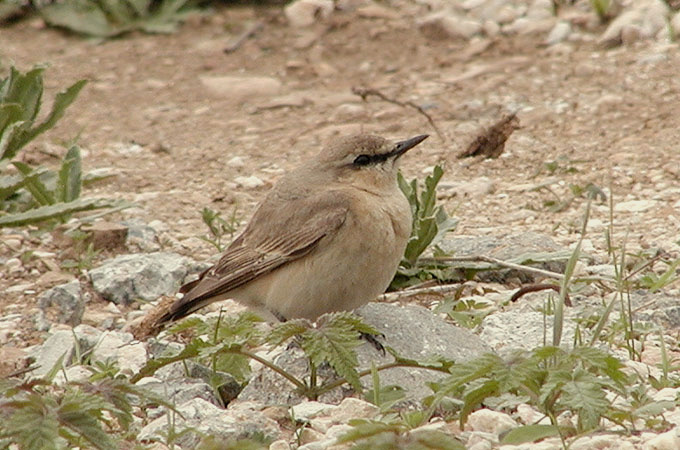
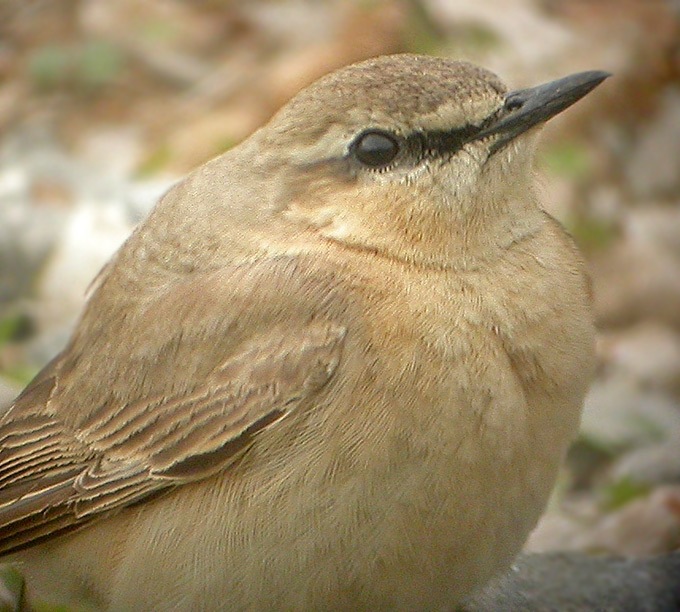
Other highlights reported by Kenji Mochizuki include the following:
Blue Rock Thrush: 02 May. One with blue belly, subspecies pandoo. Some mottling on its belly suggested that it was not in full breeding plumage.
Chinese Bulbul: First seen (MB) 02 May. This species was heard in various parts of the island, so multiple individuals might be present (or just a mobile single bird).
Japanese White-eye: 03 May. At least 2 lacked any brownish tone on flank, which would be seen in typical White-eyes in Japan.
Long-tailed Tit: 03 May. One flock of several birds seen, at least one of which was white headed caudata form.
Red-tailed Robin: Seen or heard only on 04 May.Six or seven individuals were seen in total.
Japanese Bush Warbler: One or two singing on 04 and 05 May. Some rufous-foreheaded Bush Warblers (Korean ?) also seen.
Yellow Bunting: One on 05 May.
Song Do, May 5
Inpia mudflat: now fenced off, heavily disturbed and with reclamation well underway.

A very rewarding visit nonetheless: high tide pushed a diverse array of shorebirds close inshore for good views and an approximate count. 3300 Dunlin are a personal record high for this site, so too 320 Grey Plover,ca 50 Ruddy Turnstone, 200 Great Knot, ca 350 Bar- tailed Godwit (with a few Black-tailed Godwit in amongst). In addition, 200+ Red-necked Stint, 60 Mongolian Plover, 18 "Eastern" Oystercatcher, c.20 Kentish Plover, and 20 Common Greenshank and 1 Common Sandpiper.
A new wave of Whimbrel have largely displaced several remaining Far-Eastern Curlew: 2 or 3 Broad- billed Sandpipers, several Little Terns are the first I've seen here, and around 40 Terek Sandpiper and a Striated Heron are my first birds this season.
Interestingly, up to 20 breeding-plumaged Saunder's Gull remain here, seen wolfing down crabs and mudworms.

An orange- flagged Bar-tailed Godwit provided some interest, but surprise of the day has to be the Black-Capped Kingfisher feeding in a mudflat pool, and perching on the fence nearby.
A brief look at the freshwater lagoon revealed (unusually) 2 Wigeon, a Siberian Stonechat, 40 Common Greenshank and 4 elegant Spotted Redshanks, before rain stopped play.
Eocheong Island, May 5
Limited time spent in the field due to worsening weather, with strong winds and spells of heavy rain, mixed with dust and pollen...
Very few birds present in the morning, with ca 9 Chinese Sparrowhawk through early on, still 25 Chinese Grosbeak (were over 50 on 4th), and small numbers of most thrushes (including single Siberian and Eye-browed and at least 5 Brown-headed still) and buntings. Only species showing some obvious movement seemed to be egrets and shorebirds, with e.g. a Grey-tailed Tattler on the beach, and 22+ Wood Sandpiper, a Swinhoe's/Pintail Snipe and a Mongolian Plover east.
Highlights included at least one Daurian Starling still, a Red-billed Starling seen by one or more observers, and the same or another female Black-headed/Red-headed Bunting seen very briefly in flight (when it appeared to show yellow on the rump).
Eocheong Island, May 4
In warm and almost still conditions, 16 very close Ancient Murrelet and 114 Streaked Shearwater from the ferry, along with several hundred large gulls (including ca 100 taimyrensis in "pure" flocks), and at least 2 Common and single Black-headed Gulls (both late and unusual at sea).
In addition a Pied Harrier was seen over an island en-route, and 6 Grey Heron and 7 egrets moving east over the sea suggested fairly strong diurnal passage underway.
On Eocheong, a steady arrival seemed to take place during the afternoon, with the highlight being a single flock of at least 110 Broad-billed Roller! Other migrants obviously on the move included ca 40 Black-naped Oriole, 4 or 5 Oriental and one Indian Cuckoo, 5 Chinese Sparrowhawk, ca 10 'Eastern' Yellow and one Citrine Wagtail, and 2 or 3 White-throated Needletails in among 20+ Pacific Swifts. Grounded migrants included ca 40 Eastern Crowned and 40 Pale-legged Leaf and around 30 Yellow-browed Warblers, ca 5 Asian Brown, ca 8 Yellow-rumped, 2 Narcissus and 4 Blue-and-White Flycatchers, still good numbers of thrushes (including ca 50 Pale, 15 Grey-backed, 5 White's, 5 Brown-headed, 3 or 4 Dusky, 2 or 3 Eye-browed and single Siberian Thrushes), but only small numbers of buntings (with best being ca 6 Yellow, but no sign of a female Red-headed Bunting/Black-headed Bunting which was last seen on May 3rd).


Eocheong Island, up to May 4 (AM)

With rain falling overnight on the 30th.
Water Pipit, 1. April 30. (Prior to 2002 there were just 4 records involving at least 5 individuals, all in winter - this individual is approximately the ninth or tenth)
"Red-throated" Thrush, one adult male, May 1
Ruddy Kingfisher, 1, May 1 (First record for Eocheong)
Female Black-headed Bunting, 1, May 2-3
Song Do, May 4
About 100 Saunders's Gull present in the highly-threatened colony, with some apparently already egg-laying.
Nakdong and Taejongdae, May 2
Sidra Blake and I visited the Nakdong Estuary on the 2nd of May and Taejongdae Park this morning (the 3rd of May). The fog was heavy at the Nakdong but many birds were singing. At Taejongdae the wind was horrid and birding was difficult but a fair number of migrants were present with one especially unexpected find.
Nakdong Estuary
Spot-billed x Mallard Hybrid - 1 drake, Black Kite - 1, Little-ringed Plover - 2, Kentish Plover - 5, Whimbrel - 15, Eurasian Curlew - 1, Greenshank - 12, Common Sandpiper - 1, Oriental Reed Warbler - 7+ singing & seen, Fan-tailed Warbler - 3 displaying & 1 copulation observed
Taejongdae Park
Temminick's Cormorant - 1, Black Kite - 2, Ashy Minivet - approx. 30, one flock of 25 seen, Grey Thrush - 1 male, CHINESE BLACKBIRD - 1 male, Dusky Warbler - 3, Arctic Warbler - 1, Asian Brown Flycatcher - 1, Narcissus Flycatcher - 1 incessant singing male in same location as last week. Could be on territory? No female seen yet.
Mugimaki Flycatcher - 1 male (as fun to see as to say!), Blue & White Flycatcher - male, Tristram's Bunting - 3
Dobongsan (Northeast Seoul), May 2
A slightly cooler morning. Almost all single birds, but good ones: 1 Tricoloured Flycatcher, 1 Blue-and-White Flycatcher (a female gathering nest-moss), a singing Dark-sided Flycatcher, a Yellow Wagtail, a Pale Thrush, a Scaly Thrush (also gathering nest material), numerous calling Pygmy Woodpeckers, 1 briefly-glimpsed, probable Yellow-browedWarbler. Best of all, a handsome male Siberian Thrush seen long and well.
Upo Ramsar site, May 1
Bird numbers have certainly swollen since my last visit there and there was relatively low human disturbance on this visit. Most the Grey Heron chicks are now visible poking their heads out of the nests. A few new summer residents have arrived in the past week and most birds are now in full breeding/alternate plumage.
Little Grebe - 1, Garganey - 8, Common Greenshank - 8, Spotted Redshank - 30+ many in full breeding plumage, Green Sandpiper - 1, Wood Sandpiper - approx. 85, Terek Sandpiper - 1, Common Sandpiper - 1, Pintail Snipe - 1, Long-toed Stint - 18, Little Tern - 4, Dusky Thrush - 2 (seem to be getting scarce now), Yellow-rumped Flycatcher - 2 males singing on territory & one female, Black-naped Oriole - 5 singing males
Gunsan and vicinity, May 1
A White Spoonbill was seen at the Geum. Chinese Penduline Tits were in the reeds. In the industrial area Red-necked Stints were mixed in with Sharp-tailed Sandpipers. Marsh Sandpipers were also there. At Okku a Common Redshank was in the company of Spotted Redshanks: there also a personal first of the year Oriental Great Reed Warbler was heard.
Seosan, May 1
Still one Hooded Crane present.
A total of 2 Red Knots Calidris canutus were sighted by Gillian Vaughan et al. at: Tapora Wildlife Refuge, South Kaipara Harbour, New Zealand 36deg 21min 0sec S, 174deg 15min 0sec E on 26/03/2005 with flag(s) as follows:
LEFT leg: nothing/unknown on tibia (upper leg) above nothing/unknown on tarsus, RIGHT leg: white flag on tibia (upper leg) above orange flag on tarsus
These birds were flagged in Korean Peninsula, approximate co-ordinates 36deg min S, 126deg 40min E, which uses the flag combination White/Orange, sometime since 1998.
The resighting was a distance of approximately 9428 km, with a bearing of 143 degrees, from the marking location.
Weiyeon Do (ca 15 Km NE of Eocheong Island), April 30 - May 2
Outstanding highlight was one pandoo Blue Rock Thrush (presumably the same individual that had been present on Eocheong Island on April 24th, as also a presumed first summer male).
Also:, Red-billed Starling 2, White-breasted Waterhen 2, Citrine Wagtail 1, Grey Thrush 1, Yellow-breasted Bunting 50





